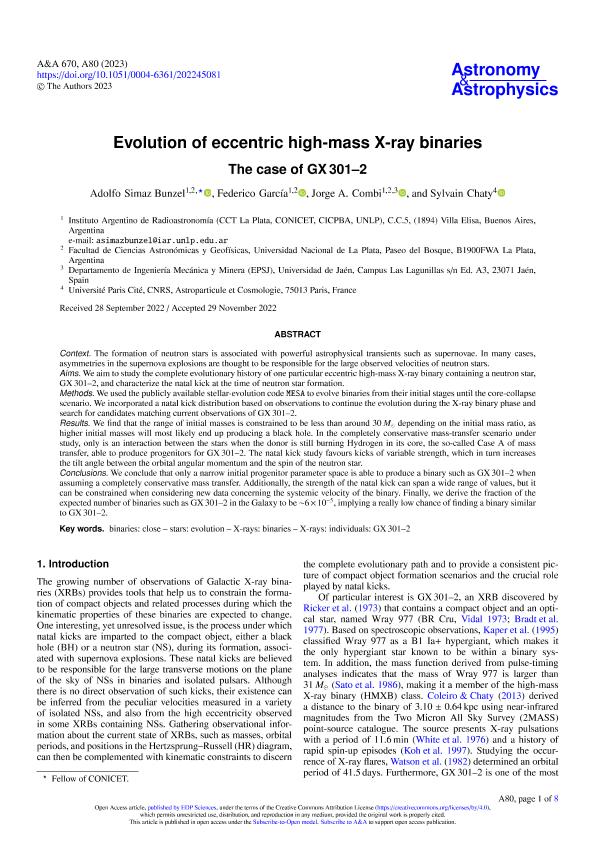Mostrar el registro sencillo del ítem
dc.contributor.author
Simaz Bunzel, Adolfo

dc.contributor.author
García, Federico

dc.contributor.author
Combi, Jorge Ariel

dc.contributor.author
Chaty, Sylvain
dc.date.available
2023-11-14T12:23:48Z
dc.date.issued
2023-02
dc.identifier.citation
Simaz Bunzel, Adolfo; García, Federico; Combi, Jorge Ariel; Chaty, Sylvain; Evolution of eccentric high-mass X-ray binaries: The case of GX 301-2; EDP Sciences; Astronomy and Astrophysics; 670; A80; 2-2023; 1-8
dc.identifier.issn
0004-6361
dc.identifier.uri
http://hdl.handle.net/11336/217989
dc.description.abstract
Context. The formation of neutron stars is associated with powerful astrophysical transients such as supernovae. In many cases, asymmetries in the supernova explosions are thought to be responsible for the large observed velocities of neutron stars. Aims.We aim to study the complete evolutionary history of one particular eccentric high-mass X-ray binary containing a neutron star, GX301-2, and characterize the natal kick at the time of neutron star formation. Methods.We used the publicly available stellar-evolution code MESA to evolve binaries from their initial stages until the core-collapse scenario. We incorporated a natal kick distribution based on observations to continue the evolution during the X-ray binary phase and search for candidates matching current observations of GX301-2. Results. We find that the range of initial masses is constrained to be less than around 30 M_ depending on the initial mass ratio, as higher initial masses will most likely end up producing a black hole. In the completely conservative mass-transfer scenario under study, only is an interaction between the stars when the donor is still burning Hydrogen in its core, the so-called Case A of mass transfer, able to produce progenitors for GX301-2. The natal kick study favours kicks of variable strength, which in turn increases the tilt angle between the orbital angular momentum and the spin of the neutron star. Conclusions. We conclude that only a narrow initial progenitor parameter space is able to produce a binary such as GX301-2 when assuming a completely conservative mass transfer. Additionally, the strength of the natal kick can span a wide range of values, but it can be constrained when considering new data concerning the systemic velocity of the binary. Finally, we derive the fraction of the expected number of binaries such as GX301-2 in the Galaxy to be _6∗10-5, implying a really low chance of finding a binary similar to GX301-2.
dc.format
application/pdf
dc.language.iso
eng
dc.publisher
EDP Sciences

dc.rights
info:eu-repo/semantics/openAccess
dc.rights.uri
https://creativecommons.org/licenses/by-nc-sa/2.5/ar/
dc.subject
BINARIES
dc.subject
BINARIES - X-RAYS
dc.subject
CLOSE - STARS
dc.subject
EVOLUTION - X-RAYS
dc.subject
GX301-2
dc.subject
INDIVIDUALS
dc.subject.classification
Astronomía

dc.subject.classification
Ciencias Físicas

dc.subject.classification
CIENCIAS NATURALES Y EXACTAS

dc.title
Evolution of eccentric high-mass X-ray binaries: The case of GX 301-2
dc.type
info:eu-repo/semantics/article
dc.type
info:ar-repo/semantics/artículo
dc.type
info:eu-repo/semantics/publishedVersion
dc.date.updated
2023-11-13T15:54:45Z
dc.journal.volume
670
dc.journal.number
A80
dc.journal.pagination
1-8
dc.journal.pais
Francia

dc.description.fil
Fil: Simaz Bunzel, Adolfo. Provincia de Buenos Aires. Gobernación. Comisión de Investigaciones Científicas. Instituto Argentino de Radioastronomía. Consejo Nacional de Investigaciones Científicas y Técnicas. Centro Científico Tecnológico Conicet - La Plata. Instituto Argentino de Radioastronomía; Argentina. Universidad Nacional de La Plata; Argentina
dc.description.fil
Fil: García, Federico. Universidad Nacional de La Plata; Argentina. Provincia de Buenos Aires. Gobernación. Comisión de Investigaciones Científicas. Instituto Argentino de Radioastronomía. Consejo Nacional de Investigaciones Científicas y Técnicas. Centro Científico Tecnológico Conicet - La Plata. Instituto Argentino de Radioastronomía; Argentina
dc.description.fil
Fil: Combi, Jorge Ariel. Universidad Nacional de La Plata; Argentina. Provincia de Buenos Aires. Gobernación. Comisión de Investigaciones Científicas. Instituto Argentino de Radioastronomía. Consejo Nacional de Investigaciones Científicas y Técnicas. Centro Científico Tecnológico Conicet - La Plata. Instituto Argentino de Radioastronomía; Argentina. Universidad de Jaén; España
dc.description.fil
Fil: Chaty, Sylvain. Université Paris Cité, CNRS, Astroparticule et Cosmologie; Francia
dc.journal.title
Astronomy and Astrophysics

dc.relation.alternativeid
info:eu-repo/semantics/altIdentifier/doi/http://dx.doi.org/10.1051/0004-6361/202245081
dc.relation.alternativeid
info:eu-repo/semantics/altIdentifier/url/https://www.aanda.org/articles/aa/full_html/2023/02/aa45081-22/aa45081-22.html
Archivos asociados
